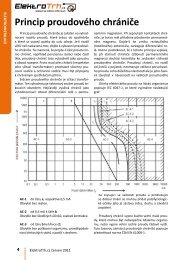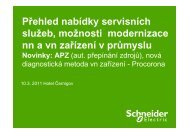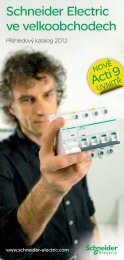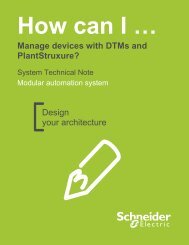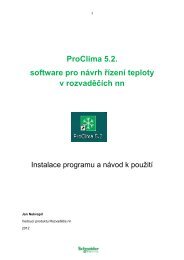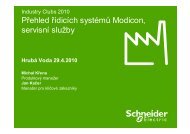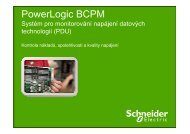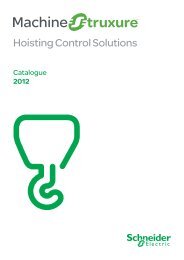2010Annual Report - Schneider Electric CZ, s.r.o.
2010Annual Report - Schneider Electric CZ, s.r.o.
2010Annual Report - Schneider Electric CZ, s.r.o.
You also want an ePaper? Increase the reach of your titles
YUMPU automatically turns print PDFs into web optimized ePapers that Google loves.
5 CONSOLIDATED FINANCIAL STATEMENTS<br />
NOTES TO THE CONSOLIDATED FINANCIAL STATEMENTS<br />
188<br />
Based on these assumptions, the amount recorded under “Selling, general and administrative expenses” for stock grant plans set up after<br />
November 7, 2002 breaks down as follows:<br />
2010 2009<br />
Plan 1 - 1<br />
Plan 2 - -<br />
Plan 3 - -<br />
Plan 4 - 1<br />
Plan 5 2 2<br />
Plan 6 2 2<br />
Plan 7 - -<br />
Plan 8 5 -<br />
Plan 9 6 -<br />
Plan 10 1 -<br />
Plan 11 - -<br />
21.5.2 Worldwide Employee Stock Purchase Plan<br />
<strong>Schneider</strong> <strong>Electric</strong> gives its employees the opportunity to participate<br />
in employee share issues reserved for them. Employees in countries<br />
that meet legal and fi scal requirements have the choice between a<br />
nonleveraged and a leveraged plan.<br />
Under the nonleveraged plan, employees may purchase <strong>Schneider</strong><br />
<strong>Electric</strong> shares at a 15% to 17% discount (depending on the country)<br />
to the price quoted for the shares on the stock market. Employees<br />
must then hold their shares for fi ve years except in certain cases<br />
provided for by law. The share-based payment expense recorded in<br />
accordance with IFRS 2 is measured by reference to the fair value of<br />
the discount on the locked-up shares. The lock-up cost is defi ned as<br />
the cost of a two-step strategy that involves fi rst selling the locked-up<br />
shares on the forward market and then purchasing the same number<br />
of shares on the spot market (i.e. shares that may be sold at any<br />
time) using a bullet loan.<br />
This strategy is designed to refl ect the cost the employee would<br />
incur during the lock-up period to avoid the risk of carrying the<br />
shares subscribed under the nonleveraged plan. The borrowing cost<br />
corresponds to the cost of borrowing for the employees concerned,<br />
as they are the sole potential buyers in this market. It is based on the<br />
average interest rate charged by banks for an ordinary, non-revolving<br />
personal loan with a maximum maturity of fi ve years granted to an<br />
individual with an average credit rating.<br />
Under the leveraged plan, employees may also purchase<br />
<strong>Schneider</strong> <strong>Electric</strong> shares at a 15% to 17% discount (depending on<br />
the country) to the price quoted on the stock market. However, these<br />
plans offers a different yield profi le as a third-party bank tops up the<br />
2010 REGISTRATION DOCUMENT SCHNEIDER ELECTRIC<br />
16 6<br />
employee’s initial investment, essentially multiplying the amount paid<br />
by the employee. The total is invested in <strong>Schneider</strong> <strong>Electric</strong> shares<br />
at a preferential price. The bank converts the discount transferred<br />
by the employee into funds with a view to securing the yield for the<br />
employee and increasing the indexation (by a factor of 3.4 in 2010)<br />
on a leveraged number of directly subscribed shares.<br />
As with the nonleveraged plan, the IFRS 2 expense, like the sharebased<br />
payment expense, is determined by reference to the fair value<br />
of the discount on the locked-up shares (see above). In addition,<br />
it includes the value of the benefi t corresponding to the issuer’s<br />
involvement in the plan, which means that employees have access<br />
to share prices with a volatility profi le adapted to institutional investors<br />
rather than to the prices and volatility profi le they would have been<br />
offered if they had purchased the shares through their retail banks.<br />
The volatility differential is treated as a discount equivalent that refl ects<br />
the opportunity gain offered to employees under the leveraged plan.<br />
In 2010, as part of its commitment to employee share ownership,<br />
<strong>Schneider</strong> <strong>Electric</strong> gave its employees the opportunity to purchase<br />
on June 8 shares at a price of EUR65.85 or EUR67.44 per share,<br />
depending on the country. This represented a discount of 15% to<br />
17% to the average opening price of EUR79.34 quoted for the share<br />
during the 20 days preceding the Management Board’s decision to<br />
launch the employee share issue.<br />
In all, 2.2 million shares were subscribed, increasing the Company’s<br />
capital by EUR143 million as of July 8, 2010. The issue represented<br />
a total cost of EUR3.4 million, taking into account the fi ve year lockup<br />
period.




